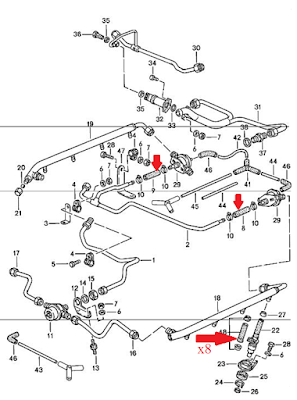The engine bay was finally all back together. The parts for the work were not all that expensive however the amount of labour involved was quite extensive. If we had taken this to even the most inexpensive mechanic it would have cost more than what was paid for the car just for this clean up.
Here is a total list of what was done during this work:
- All fuel line rubber was replaced
- Almost all of the vacuum hoses were replace
- The spark plugs were replaced
- New fuel filter
- Thermo valve replaced
- New gaskets for each intake manifold
- New rubber couplers between plenum and intake manifolds
- New hose clamps for rubber couplers
- Rubber coupler and hose clamps between throttle body and plenum replaced
- Small coolant return hose replaced
- Oil separator gasket replaced
- Oil change and new oil filter
- Battery changed out
- Battery disconnect installed
- Battery charger/maintainer hard wired to car with quick disconnect
- Sunroof was cleaned, serviced and lubricated
- New air tubes were installed
- Plenum and intake manifolds were extensively cleaned
- Air guide housing mounts were replaced
- injector outer and inner bushings replaced
- Chin protector plates installed
- Strut cross brace had paint removed and was cleaned up
After all of that work the engine bay looks absolutely beautiful now. The contrast was quite striking as can be seen in the side-by-side comparison below. There are still a few things such as the rad hoses and all the belts that still need to be replaced but that will be done with the timing belt in an up coming working session. Now that all this work had been done and everything was now re-assembled it was time to try to restart the car.
BEFORE AFTER
 First thing we needed to do was to check that there were no fuel leaks what-so-ever anywhere on the car. This requires the three senses of sight, touch and smell. You look and see if any leaks can be seen, you touch each joint to see if you can feel any leaks and you also smell. You smell the area in general and also your fingers after the touch test. Any of these fail and you need to fix the issue before even thinking of moving on. Before you both with that, of course, you need to pressurize the fuel system. Basically the whole system has no fuel in since it was completely drained and taken apart. The best way to do this is to jumper the fuel pump relay with a wire so the pump runs without the key in the on position. (See picture to the right) This will fill and pressurize the fuel lines and enable you to check to see if you have any fuel leaks. We cleared the drive way in front of the garage, rolled the car out a safe distance and had two voluntary fire fighters standing by with the appropriate fire extinguishers ready to go as we validated. We actually had a connection that failed the test and need to be adjusted. It was simple matter of not being properly tightened but had we not done these extensive checks it would have cause a serious issue at some point.
First thing we needed to do was to check that there were no fuel leaks what-so-ever anywhere on the car. This requires the three senses of sight, touch and smell. You look and see if any leaks can be seen, you touch each joint to see if you can feel any leaks and you also smell. You smell the area in general and also your fingers after the touch test. Any of these fail and you need to fix the issue before even thinking of moving on. Before you both with that, of course, you need to pressurize the fuel system. Basically the whole system has no fuel in since it was completely drained and taken apart. The best way to do this is to jumper the fuel pump relay with a wire so the pump runs without the key in the on position. (See picture to the right) This will fill and pressurize the fuel lines and enable you to check to see if you have any fuel leaks. We cleared the drive way in front of the garage, rolled the car out a safe distance and had two voluntary fire fighters standing by with the appropriate fire extinguishers ready to go as we validated. We actually had a connection that failed the test and need to be adjusted. It was simple matter of not being properly tightened but had we not done these extensive checks it would have cause a serious issue at some point.Now that all the joints and hoses passed all checks we were in the position of trying to re-start the car. We removed the jumper and replaced the fuel pump relay. After a few final checks, like did we have any gas in the tank, we gave it a go hoping it would come back to life. The video below shows the first attempt at restart.
The next thing on our list is to repair the angular joint at the front end of the shifting mechanism. Stay tuned!




























